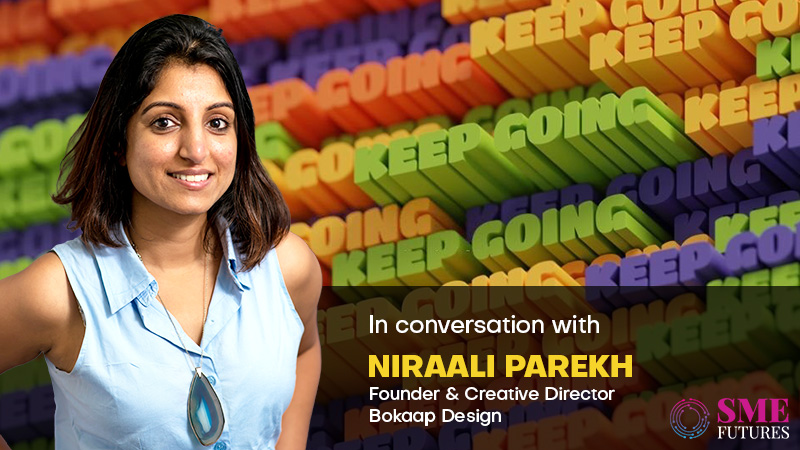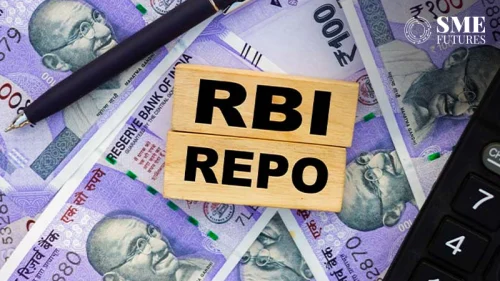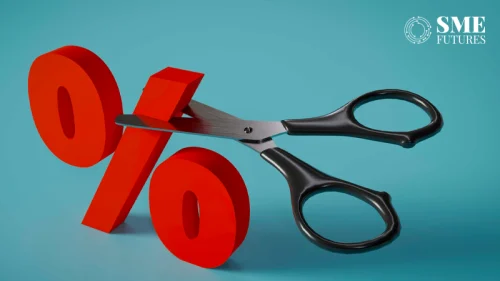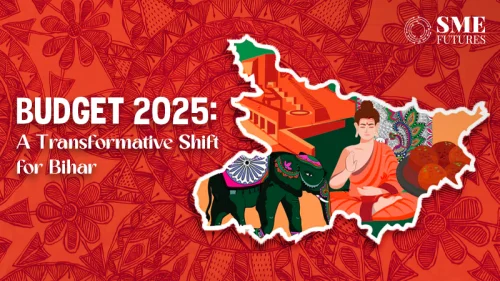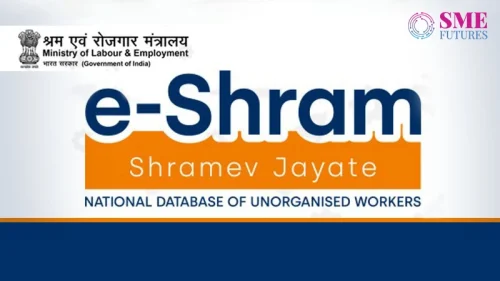There’s no doubt that women are creative beings! And they are making waves in the UX/UI design field, making up around 53.5 per cent of the design workforce, according to AIGA and Google’s combined study for 2019. However, only 11 per cent of them are in leadership positions. Perhaps as of now the numbers could have ascended. It should be, as businesses heavily depend on the design element as a part of their success blueprint.
One of the female leaders representing women in design is Niraali Parekh, Founder and Creative Director of Bokaap Design. She lives and loves design, besides travelling which is her other passion. Design is more than just a passion for her, and she loves it because it inspires her to solve problems. Now after 11 years in this the field, Parekh aims to strengthen her company’s focus on several verticals, along with the female workforce that she works with. In a conversation with SME Futures, Parekh shares her lesser-known side with us.
Edited excerpts:
How would you describe yourself as a person?
I am a very accountable and organised person. Punctuality for me is of utmost importance. I am adventurous and love taking up a good challenge. I always want to do something I have never done before. This challenge keeps me going. And I love problem-solving. Design (Branding, packaging or tech platforms) is at the deepest level of problem-solving.
Can you tell me about your childhood, who inspired you, and what did you want to become when you were a little girl?
I come from a family of entrepreneurs. My great grandfather was a plywood trader in Mumbai who started his shop in the early 1900s. My grandfather took this ahead and expanded the trade and was instrumental in Vile Parle becoming the hub of traders for construction materials, often giving loans to new entrants to become businesspeople. Eventually, my father took over, diversified the business and started multiple new ventures: some succeeded and some failed. I often tell people that our parents or grandparents had their own “start-ups” long before it even became a term. And that too while having to support a spouse and young kids when they were themselves so young and just starting in the field.
I have seen this entrepreneurial spirit ever since I was a child. I saw the hard work in building something; I also witnessed many lows upfront.
My parents put a lot of emphasis on sports and arts. So not only was I a brown belt level 2 in Karate, but I was also a national level figure skater. I represented Maharashtra in several skating championships across India, winning several medals and the best skater awards. Waking up at 5 am to practice, going to school, completing my homework enroute to the second practice of the day, eating dinner enroute to going home, sleeping, and repeating. And the competitions themselves taught me tenacity, teamwork, and discipline.
I applied (by sheer luck) and got accepted to study at the prestigious UWC Mahindra College for my 11th and 12th grades. Very few families would send a 16-year-old girl to live in a boarding school with 70 per cent of students from all over the world. My grandfather was instrumental in convincing my father to not let me pass on an opportunity that could change my life.
While I was always good at drawing and always wanted to pursue a career in the creative field, I did not know my options. My introduction to creative thinking happened at UWC. The exposure to diversity was tremendous from a young age. UWC prepared me to study abroad, and I graduated from Savannah College of Art and Design with a degree in graphic design.
While in college, my parents back home were going through a difficult time vis-a-vis the business. I wanted to ensure that I did not add to their stress and worked through college for my own pocket money. I learned a lot about business, work ethics, time management, and the perks of being a humble and honest worker. I also experienced criticism and how to handle it. Eventually, after graduating in 2004, I secured a job in the USA in the design industry and worked there until I returned to India in 2009.

After studying in the US and working there, what motivated you to come back to India and start your entrepreneurial journey?
When I was a student in the US, I had attended a seminar where one of the partners of Pentagram Design was the main speaker. He was walking us through some of the firm’s work.
Inspired by the idea of a collaborative studio environment, the seeds to set up a boutique design studio where experts from different fields like design, content creation, marketing and technology can come together as a collaborative team were sown there.
I was a part of the “reverse brain drain” around 2009-2011. Like me, 100s of America educated Indians were coming back to India to join their family businesses or to set up their own companies. So, it was a natural conclusion that I would set up my studio in Mumbai, India. I happened to be at the right place at the right time as some of my early clients were from this group.
At that time, there were not many design studios in India. Large advertising agencies would set up internal studios to take care of branding work, but there were very few standalone boutique design studios in India. So, with my graphic design skills, web design, and web development, I set out to get any and every type of project that came my way. I was what they call today a “UX Unicorn”.
So, what advantages does your company have over your competitors?
We are focused on human-cantered design. Which means putting people at the core of all our work! We understand the people behind the product(s), the people the product is intended for, and work as a team through ideations and iterations with the people designing the product. Design thinking is a human-centred design approach, and we follow this process for all our projects.
We are also a founder-led, lean team – ensuring that the brief does not get lost in the hierarchy of different team members. What is pitched and promised is always delivered while working with the client as a collaborator through all our projects.
And recently Bokaap Design rebranded. With our focused approach on branding and UX/UI solutions for tech, we can be more strategic in the type of projects we undertake. Now we are more collaborative, and the engagements are more long term for the duration of the product cycle.
Did you ever encounter gender bias issues while working in a male-dominated environment?
I have been fortunate that in the 11 years of running my studio, I have come across very few gender biases or glass ceiling instances. A large part of it has to do with me running my own company and having the flexibility to choose who I work with.
I would not take on the project if I felt I was being taken advantage of or disrespected. There have been a couple of instances where I have walked away from working with big-name corporates.
Being a woman and a small business, they were trying to squeeze my time, resources and skills beyond what was agreed upon -minimum pay-out to begin with. I stood my ground and decided for my team (also all girls) and focused on developing the kind of company culture, that I wanted. Letting go of these clients was one of the best decisions that I made. My team appreciated the fact that I was looking out for their best interests, and that I would not have my clients talk down to them.
How do you think business has changed over the years when it comes to the design and tech space?
In 2010, when I started my studio, there were very few boutique design studios. But the tech boom was also gradually happening. The market opened up. In India, more entrepreneurs emerged, producing D2C products or developing tech products. This resulted in an increased awareness of design and the need for good design to stand apart and appeal to the consumers. “UX/UI Design” emerged globally as a new field like an offshoot of “Web Design” and “Human-Computer Interaction” or “Interaction Design”.
Nowadays, it’s impossible to build a tech product without a good designer on board. So yes, we have become an integral part of any business. While there is still some way for us to go in India, I believe it will only get better from here onwards in terms of the remuneration for design services.
What’s the roadmap for Bokaap Design going ahead?
Ever since I started the studio, my goal has been to stay relevant according to what is happening in the market. With every new technological innovation, we have improved on our service offerings. I continue to make that my mission.
My vision is to now take up UX/UI projects in the AR/VR space and wearable technology. I want to focus on the B2B Tech, EdTech, MedTech and FinTech spaces.
My business up to this point was 80 per cent in India and 20 per cent were global clients. I want to grow my business abroad so that there is a balance of clients from across the globe.
What’s your favourite pastime? We heard you love traveling, what’s on your bucket list for 2022?
I love learning new things and I love being active. Since 2015, I have been learning Spanish, intending to be completely fluent. I travelled solo to Spain in 2017 to study abroad and immerse myself in the culture.
Being a sports enthusiast, every holiday is an active holiday. From skiing, diving, surfing, wind surfing, stand up paddling, or even hiking, I ensure that my holidays are planned around one of these activities.
My bucket list for 2022 is to travel to Macchu Picchu, Peru. My three passions combined together – the love of Spanish, art and culture, and an active holiday. I plan to trek the Salkantay Trail. I hope it happens this year!
What advice would you give to the budding entrepreneurs or the women in this field?
Stay on the path and do not give up. Working enabled me to be financially independent and have my own identity that was not attached to any male member. This was my biggest saviour when I was at the lowest point of my life post my divorce.

